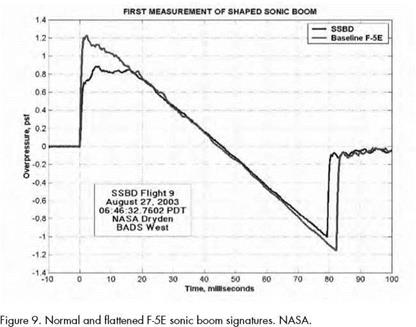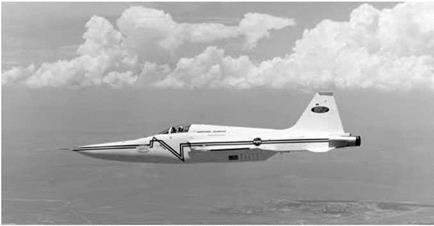Breaking Up Shock Waves with "Quiet Spike"
In June 2003, the FAA—citing a finding by the National Research Council that there were no insurmountable obstacles to building a quiet supersonic aircraft—began seeking comments on its noise standards in advance of a technical workshop on the issue. In response, the Aerospace Industries Association, the General Aviation Manufactures Association, and most aircraft companies felt that the FAA’s sonic boom restriction
was the still the most serious impediment to creating the market for a supersonic business jet (SSBJ), which would be severely handicapped if unable to fly faster than sound over land.[511]
By the time the FAA workshop was held in mid-November, Peter Coen of the Langley Center and a Gulfstream vice president were able to report on the success of the SSBD. Coen also outlined future initiatives in NASA’s Supersonic Vehicles Technology program. In addition to leveraging the results of DARPA’s QSP research, NASA hoped to engage industry partners for follow-on projects on the sonic boom, and was also working with Eagle Aeronautics on new three-dimensional CFD boom propagation models. For additional psychoacoustical studies, Langley had reconditioned its boom simulator booth. And as a possible followup to the SSBD, NASA was considering a shaped low-boom demonstrator that could fly over populated areas, allowing definitive surveys on public acceptance of minimized boom signatures.[512]
The Concorde made its final transatlantic flights just a week after the FAA’s workshop. Its demise marked the first time in modern history that a mode of transportation had retreated back to slower speeds. This did, however, leave the future supersonic market entirely open to business jets. Although the success of the SSBD hinted at the feasibility of such an aircraft, designing one—as explained in a new study by Langley’s Robert Mack—would still not be at all easy.[513]
During the next several years, a few individual investors and a number of American and European aircraft companies—including Gulfstream, Boeing, Lockheed, Cessna, Raytheon, Dassault, Sukhoi, and the privately held Aerion Corporation—pursued assorted SSBJ concepts with varying degrees of cooperation, competition, and commitment. Some of these and other aviation-related companies also worked together on supersonic strategies through three consortiums: Supersonic Aerospace International
|
|
(SAI), which had support from Lockheed-Martin; the 10-member Supersonic Cruise Industry Alliance (SCIA); and Europe’s High-Speed Aircraft Industrial Project (HISAC), comprising more than 30 companies, universities, and other members. Meanwhile, the FAA began the lengthy process for considering a new metric on acceptable sonic booms and, in the interest of global consistency, prompted the International Civil Aviation Organization (ICAO) to also put the issue on its agenda. It was in this environment of both renewed enthusiasm and ongoing uncertainty about commercial supersonic flight that NASA continued to study and experiment on ways to make the sonicboom more acceptable to the public.[514]
Richard Wlezien (back from DARPA as NASA’s vehicle systems manager) hoped to follow up on the SSBD with a truly low-boom super-
sonic demonstrator, possibly by 2010. In July 2005, NASA announced the Sonic Boom Mitigation Project, which began with concept explorations by major aerospace companies on the feasibility of either modifying another existing aircraft or designing a new demonstrator.[515] As explained by Peter Coen, "these studies will determine whether a low sonic boom demonstrator can be built at an affordable cost in a reasonable amount of time.”[516] Although numerous options for using existing aircraft were under investigation, most of the studies were leaning toward the need to build a new experimental airplane as the most effective solution. On August 30, 2005, however, NASA Headquarters announced the end of the short-lived Sonic Boom Mitigation Project because of changing priorities.[517]
Despite this setback, there was still one significant boom lowering experiment in the making. Gulfstream Aerospace Corporation, which had been teamed with Northrop Grumman in one of the canceled studies, had already patented a new sonic boom mitigation technique.[518] Testing this invention—a retractable lance-shaped device to extend the length of an aircraft—would become the next major sonic boom flight experiment.
In the meantime, NASA continued some relatively modest sonic boom testing at the Dryden Center, mainly to help improve simulation capabilities. In a joint project with the FAA and Transport Canada in the summer of 2005, researchers from Pennsylvania State University strung an array of advanced microphones at Edwards AFB to record sonic booms created by Dryden F-18s passing overhead. Eighteen volunteers, who sat on lawn chairs alongside the row of microphones during the flyovers to experience the real thing, later gauged the fidelity of the played-back recordings. These were then used to help improve the accuracy of the booms replicated in simulators.[519]
“Quiet Spike” was the name that Gulfstream gave to its nose boom concept. Based on CFD models and results from Langley’s 4 by 4 super-
|
Close-up view of the SSBD F-5E, showing its enlarged "pelican” nose and lower fuselage designed to shape the shock waves from the front of the airframe. NASA. |
sonic wind tunnel, Gulfstream was convinced that the Quiet Spike device could greatly mitigate a sonic boom by breaking up the typical nose shock into three less-powerful waves that would propagate in parallel to the ground.[520] However, the company needed to test the structural and aerodynamic suitability of the device and also obtain supersonic in-flight data on its shock scattering ability. NASA’s Dryden Flight Research Center had the capabilities needed to accomplish these tasks. Under this latest public – private partnership, Gulfstream fabricated a telescoping 30-foot-long nose boom (made of molded graphite epoxy over an aluminum frame) to attach to the radar bulkhead of Dryden’s frequently modified F-15B No. 836. A motorized cable and pulley system could extend the spike up to 24 feet and retract it back to 14 feet. After extensive static testing at its Savannah, GA, facility, Gulfstream and NASA technicians at Dryden attached the specially instrumented spike to the F-15’s radar bulkhead in April 2006 and began conducting further ground tests, such as for vibration.[521]
After various safety checks, aerodynamic assessments and checkout flights, Dryden conducted Quiet Spike flight tests from August 10, 2006 until February 14, 2007. Key engineers on the project included Dryden’s Leslie Molzahn and Thomas Grindle, and Gulfstream’s Robbie Cowart. Veteran NASA test pilot Jim Smolka gradually expanded the F-15B’s flight envelope up to Mach 1.8 and performed sonic boom experiments with the telescoping nose boom at speeds up to Mach 1.4 at 40,000 feet. Aerial refueling by AFFTC’s KC-135 allowed extended missions with multiple test points. Because it was known that the weak shock waves from the spike would rather quickly coalesce with the more powerful shock waves generated by the rest of the F-15’s unmodified high-boom airframe, data were collected from distances of no more than 1,000 feet. These measurements, made by a chase plane using similar probing techniques to those of the SR-71 and SSBD tests, confirmed CFD models on the spike’s ability to generate a sawtooth wave pattern that, if reaching the surface, would cause only a muffled sonic boom. Analysis of the data appeared to confirm that shocks of equal strength would not coalesce into a single strong shock. In February 2007, with all major test objectives having been accomplished, the Quiet Spike F-15B was flown to Savannah for Gulfstream to restore to its normal configuration.[522]
For this successful test of an innovative design concept for a future SSBJ, James Smolka, Leslie Molzahn, and three Gulfstream employees subsequently received Aviation Week and Space Technology’s Laureate Award in Aeronautics and Propulsion. One month later, however, both the Gulfstream Corporation and the Dryden Center were saddened by the death in an airshow accident of Gerard Schkolnik, Gulfstream’s Director of Supersonic Technology Programs, who had been a Dryden employee for 15 years.[523]












